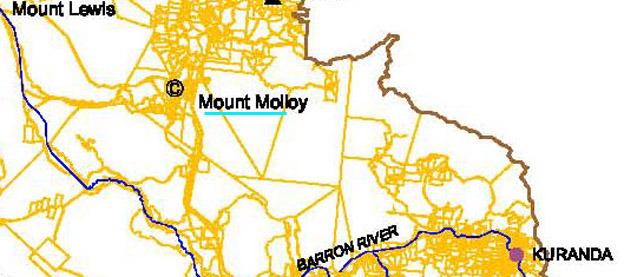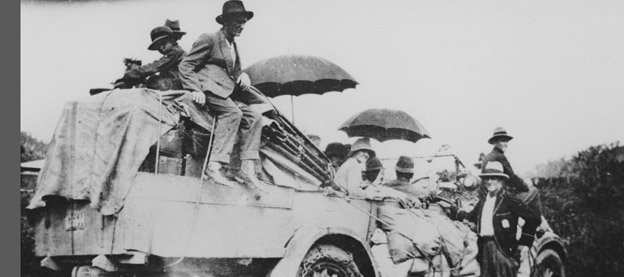
The first permanent dwelling in the district was built at Mitchelvale by the Fraser Brothers, John and Harry in 1876. Frasers supplied beef to Palmer River gold miners.
In April 1877, Christie Palmerston and a mate blazed a track from Hodgkinson Gold filed to what is now Port Douglas. With government finance, road works on the bump section saw wheeled traffic using this track from September 1877, in preference to the steeper track to Trinity Inlet, Cairns. Enterprising people set up shanties about every seven miles along the track.
There is some evidence that Hughes’ “Carrier Arms Hotel” was among the first of these wayside inns. The birth place of George Alfred Hughes was recorded at Port Douglas – Mount Molloy, on 20.01.1878. But there was no town registered as Mount Molloy until after 1896.
Murphy and MacDonald started a coach service from Port Douglas to the Hodgkinson and other mining fields in July 1882. Two months later Cobb & Co bought the partnership out and extended the service to Georgetown.
The first recorded death in the area was that of William Madely Hughes, hotelier, from The Carriers Arms Hotel, near Spear Creek. On Sunday, July 29, 1883, Mr Hughes, two sons and another boy had a horse race. Mr Hughes collided with a tree and soon died from head and chest injuries without gaining consciousness. Mr Hughes is buried in the Port Douglas Cemetery.
About 1885, teamster Tom Cuddihy, found an outcrop of greenish stone on a hill, not far from Rifle Creek, while looking for his strayed bullock team. He reported his find to his mate, Patrick Molloy, who sampled it and found it to be high grade copper-ore.

Patrick gave up bullock driving to work his copper claim. He sank a forty-foot shaft and shipped out his hand-picked copper ore from Port Douglas. Patrick worked his mine for a few years, but relinquished the claim when copper prices fell. Patrick Molloy started his Rocky Plains cattle run at Rocky Creek, near today’s town of Walkamin. Copper prices improved about 1891, so James Forsythe and James (Venture) Mulligan took up Molloy’s old copper lease and sank another forty-foot deep shaft. They sold hand-picked copper ore and cleared three thousand pounds £3,000 ($6,000).
The area around Patrick’s copper mine became known as Molloy’s Mountain.
According to surviving mining records, Mount Molloy copper mine exported 1153 tons of hand-picked copper ore between 1895 and 1903. The Mount Molloy Mining Company employed forty men at the mine in 1903. The smelter was blown in on 25th November 1904. Some 250 men were employed at the mine and smelters by 1907 when the Company’s managers were Tony Linedale and Jim Horsbutgh.
The mine produced 42,000 tons of ore from 1902 to 1908; which smelted down to 3,511 tons of 90% copper.

A police station opened in 1904 and a store was opened by W. Dearnaly in 1905. A postal receiving office operated from 1901 to 1905. In 1906 it became a post office before closing in 1914.
The mining company’s parent company, Irvinebank Mining Company, took up wolfram leases at Mount Carbine, and alluvial tin leases at Mount Spurgeon, in 1906. World overproduction of copper in 1906 caused another copper slump in 1907. To cut transport costs, the Mount Molloy Mining Company, began to build a railway branch line from twenty mile distant Biboohra. Late arrival of rails and a prolonged wet season escalated the costs above estimate. The job was completed eight months later than originally estimated and financially embarrassed the company. The railway arrived at the smelter in August 1908. The smelters reopened for a final clean up and closed at the end of the year, putting nearly a hundred men out of work.
To utilise the railway, Mount Molloy Mining Company secured a timber concession from the government, to harvest ten million super feet of millable timbers within a five-mile radius of Mount Molloy. The small saw mill near the smelter had insufficient capacity to mill all the logs that came in, so the company set up a saw mill in Mareeba.
John Michael Johnston was known to John Moffat and came to Mount Molloy about 1913. He set up a saw mill; the ruins of which you can see across the road from Mount Molloy General Store. The boilers, said to be one of Queensland’s only bricked-in boilers, operated the high-pressure-steam Sentinel engine, rated at about fifty horse power, with a steam-powered ship’s winch to operate the derrick which was used to unload logs from the railway wagons. The saw mill employed fifty workers. The planning shed was burnt down in January 1934. It was repaired and continued to work until the saw mill was destroyed by fire in 1962.

In 1914, the smelter town (also known as the ‘Smelly Town’ when the smelters were working) had one hotel, T. Carrol’s, later Nissan’s Smelters Hotel; four shops owned by J. Newell, P. Grogan, J. R. Boyett, and H. Wah Tay. F. Crowley was the butcher and J. M. Johnstone had the sawmill which he bought from the Mount Molloy Mining Company Ltd. There was a School of Arts hall, and between the two towns of Mount Molloy, was a school and hospital.
In 1926, the railhead was extended to Rumula. Close to the Bump Road from Port Douglas where the road crossed Spear Creek was Anderson’s Hotel, while Forsayth had another hotel between the two Molloys.
There was a general exodus of Mount Molloy saw mill workers for Mareeba, Tully, Mossman and other towns. The railway closed in 1964 and the rails were pulled up. Jack and Newell’s store closed soon after.
Rankine (Sic) Brothers bought the Cooktown saw mill and two saw benches. It was re-erected at Mount Molloy. This all-electric saw mill was operational about 1968 and employed about eight locals until its final closure in 1986.
Roche Bros. of Melbourne reopened the Mount Carbine wolfram mine in 1969, which eventually employed over one hundred workers. This was a great boost to the area until the mine closed, due to rising costs and lower commodity prices in 1986.
Text taken from:
1. Queensland Mining Journals at Resource Industries Department.
2. Mareeba ‘Cobb & Co.’, Cairns Historical Society, Bulletin No 5, March 1959.
3. Carriers Arms Hotel information was from inquest report on the death of William Madeley Hughes.
4. Transcribed by Helen Kindt, September 2010, Mareeba Historical Society, from material by Peter Justice (date unknown).
5. ‘Angor to Zillmanton: stories of North Queensland’s deserted towns’ by Colin Hooper (2002).



